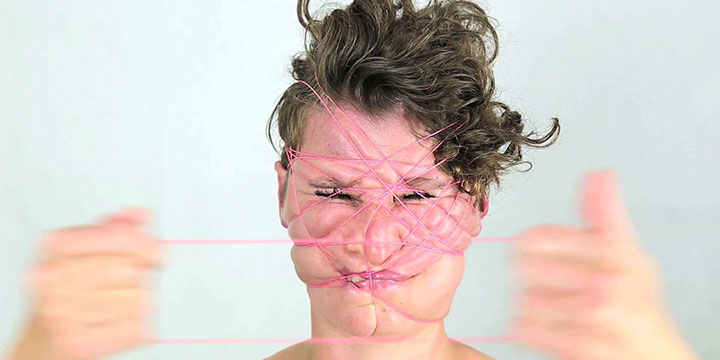Rebecca Lenon
I could never do like you do, 2010
An image of a North Korean mass celebration was retranslated in an industrial warehouse turned art gallery in Liverpool; reduced from millions of people to 31, from military uniforms to Primark & H&M clothing with the tags still on, and from flags to A4 sheets of paper.
During the performance, each participant stood for 4 hrs (half a British working day) with a 20 min break, for a share of the value of the performance. The aerial image of control is broken by a video zooming in on the individuals to reveal an accidental choreography of waving arms, shaking, blinking, itching noses and chewing mouths. The share contracts are framed, stacked and spot lit.
Janet Biggs
Duett, 2010
Duet is focused on NASCAR racing, and brings Biggs into new territory; auto racing’s wild popularity and position within consumer culture creates both drama and heroism. Rather than focusing exclusively on the drivers, Biggs presents the speed, precision, and agility of the pit crews and reveals their extreme grace under pressure. This video, Duet (2010), was screened for the first time at The Mint Museum in Charlotte NC. Commissioned from the artist, it will remain in the Museum’s permanent collection.
Mark Raidpere
Majestoso Mystico. Stockholm – Tallinn 26.04.07
Mark Raidpere's video-installation "Majestoso Mystico" (2007) is a connection between synchronical scenes in two cities Stockholm and Tallinn, representing so different political realities.
At the same time when the artist was filming calm streets of Stockholm spiced up with a catchy tune of a horror film, there was a violent riot taking place on the streets of Tallinn - an outcome of a quarrel between Russian speaking youngsters and Estonian police. The event, the so called Monument Scandal, which was triggered by Estonian Goverments plan to remove a World War II memorial with a Russian soldier from the city centre to a military cemetery of Tallinn, definitely caused a major shift in the local mental climate. The concerned artist who couldn´t be present at the historic moments and who returned to his hometown a few days later, still facing streets with the smashed shopping windows, started to work on the material. In his 2 channel installation he uses the images filmed from Stockholm and TV footage from Tallinn. The connection between synchronical scenes in two cities representing so different political realities are stressed on barely visible interpersonal level - in the nervous hand-writing of the music score scribbled out by Björn.
Björn Drenkwitz
10 Minutes, 2009
Ten people were filmed seperately with the task of measuring the elapsing of 10 minutes (without a watch) and anouncing each minute. The individual and different perception of time each performer has is measured against the viewers own perception and measuring of time.
Adad Hannah
Six Russians Eating Ice Cream, 2011
Taking as his inspiration the early 20th Century work of Sergeii Prokudin-Gorskii, the Russian pioneer of colour photography, Hannah traveled to Russia in the summer of 2010 to begin recording small slivers of Russian life in videos and photographs. Having returned from this trip with hours of footage and hundreds of photographs, it took over a year to arrive at the final selection of moving and still images. This body of work exists somewhere between the candid documentary snapshots of Robert Frank, the highly staged images of Jeff Wall, and the mid 19th century parlour pastime of tableaux vivants. Somewhat less controlled than his previous videos, Hannah's subjects pulse with life even as they try to remain still.
Lene Markusen
Afrika, 2009
Back in his homeland the burnt-out development aid worker Falk undergoes a ritual of reintegration. The local community confronts him with the issue: “Either adapt to the customs or leave the country.” Can the circumstances and his needs – his search for warmth and security – make him approve of a crime and even take part in it himself?
Stefan Panhans
Sorry, 2010
In Stefan Panhans’ quite hypnotic video »Sorry« (2010) we see a somehow nightmarish, jam-packed train ride of a bunch of restless, tired and closemouthed people looking like half-professional, contemporary celebrity lookalikes; among others, in company of lots of XXL-coffee-to-go cups, a ghost of a 1930’s dirndl, two police officers in full rig, a jogging zombie and the military. Appearing absent and wordless, they carry all sorts of strange luggage looking like remains of a department store plundering and seem to follow certain unknown ritual rules until everything starts again.
Jaan Toomik
Oleg
25 years after his discharged from the Soviet army, a former soldier embarks on a ritual journey to a faraway village graveyard to free himself from haunting memories and guilt related to a tragic accident in the army.
Martina Wolf
Day of Victory, 2009
The center of the video works “Day of Victory” are placed the large video monitors in the center of Moscow. On May 8 and 9 show these displays no advertising. They send scenes from the Second World War, striking excerpts from the numerous productions of the Soviet Union and Russia, mounted and placed under the slogan of the holiday.
In five minutes go dramatic military operations over in the triumph of the Red Army, the winner. The oath of pride and remembrance ends the sequence before it starts again.




































